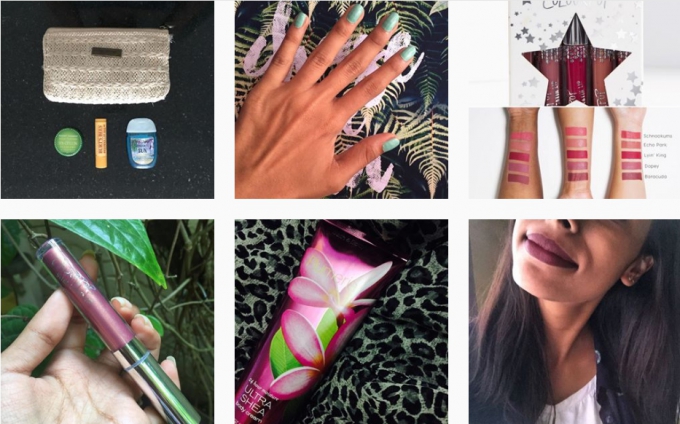
Shabna Cader runs three home businesses—selling makeup, stationery, and handbags. Importing her products from the USA and Singapore, she makes a tidy little profit—all through Instagram.
Social media has evolved fast—from platforms designed purely for social interaction, it metamorphosed into one which allows commercial exchanges as well; thereby allowing smaller businesses and startups to flourish. This held true for both Facebook and Instagram, but changed with Facebook’s explore feed restrictions, compelling users to gravitate towards the latter.
Roar Media spoke to several business owners—from craftsmen, to home bakers, to makeup and stationery suppliers, to learn more about their how and why they use Instagram as a business platform, and about the challenges they face.
Visibility And Mainstream Product Placement

Pictures allow people to visualise how the products would look on them, especially where make-up or accessories are concerned. Image credit: instagram.com/the_beauty_avenue
The platform initially intended for aspiring (and amateur) photographers to display their work is now so much more—from emulating Snapchat’s stories, to adding their own touch, like the carousel photo post. Instagram’s business blog promises its advertisers a ‘seamless experience’ which they can utilise to create interesting and interactive advertising content.
This makes it relatively easy to use, especially for small and home business startups within Sri Lanka. With its regular feed for curated posts and stories, to ‘behind the scenes’ updates, Instagram allows its advertisers to present both their professional side, and quirky, casual sneak-peeks.
For Cader, interaction is important. She updates her accounts’ stories regularly, and often tags and engages with her users—about 3000 of them on two business profiles.“I use Instagram over other forms of social media and marketing because pictures say a lot. For example, make-up and handbags are more aesthetically pleasing and can be arranged better in a picture than in a shop. You’re able to see the design, and the colour of a certain palette against your skin—and you’re able to visualise it better,” Cader said.
The same sentiment was echoed by Yasmeen Abdeen, a home baker specialising in custom-made delicacies. Convenience aside, it is also much easier for customers to correspond directly with the business.
Speaking on why they opted to showcase their products in the digital sphere, as opposed to approaching mainstream outlets to market their items, Cader highlighted what the department store’s perspective would be when approached by an unheard-of small business.
“If you’re a really small business and approaching a store to ask them to display your items, why should they trust you? That’s a disadvantage—not having those connections and trust, plus your products being sidelined by hundreds of other wares they have to offer,” she said.
This, however, was the opposite for Crystal Koelmeyer, who co-founded a business supplying hand-crafted and crocheted shoes. Following positive reviews and success online, Koelmeyer was approached by a couple of local fashion brands offering her shop space to sell her products.
Of the two stores that offered to showcase her shoes, one venture was unsuccessful and eventually discontinued, while the other still receives a steady supply of about 500 shoes every two months.
Koelmeyer’s brand has over 5000 followers, many of them repeat customers. She completes about 250 orders each month, and is now considering launching an interactive website through which customers could design their own shoes.
Until then, she shares feedback she receives from customers on her Instagram feed, for potential new customers to gauge user satisfaction, in addition to using the platform’s advertising tools for targeted promotions and reach.
Challenges For Small Business Owners

For Abdeen, one of the biggest challenges is high competition and lack of regulation. She pointed out that in the USA and UK there are regulatory bodies to ensure quality.
“You need to have a cottage industry certification, and there are regular inspections as well. You can’t advertise anything without the certification, whereas here just about anybody and everybody can do what they want,” she said.
Subsequently, there are poor standards of hygiene and production, often resulting in lower prices and the overall quality of the produce.
Cader’s competitors are also a challenge for her, especially since the items she sells are on the pricier end of the spectrum. Knockoffs and cheaper products are sold for sums a fraction of the price she sells her items off for. She recognizes, however, that this depends on a customer’s requirement.
“Some people don’t really care about the brand of the products they use, as long as it smells or looks good. Other people are a lot more brand conscious, and I always provide authentic products—so of course it’s quite a bit more expensive.”
What she does to counter this is to inform her customers of the item’s original dollar rate, and service charges for getting it down.
For Koelmeyer, working with third parties and ensuring efficiency is the largest challenge yet, and one which she hasn’t found a solution for to date.
“When I started out people didn’t even want to deliver our stuff because we were really small scale compared to their bigger clients. Now we work with different delivery companies, but there’s still a lot of inefficiency. Reliability [which my brand built for itself] doesn’t come from third parties… for instance, there were a number of orders to be delivered on Valentine’s Day, but none of them were completed. The couriers weren’t even reachable when we tried getting through to them,” she elaborated.
However, she does face issues with people copying her designs as well. While Instagram is a great platform to display creativity, it also attracts people who keep tabs on small businesses to plagiarise their ideas. This forces small businesses like hers to keep innovating new designs, Koelmeyer added.
It’s not just small businesses—local radio channels like the Sri Lanka Broadcasting Corporation stated they increased their number of listeners thanks to promotions conducted through social media—but did not reveal numbers. Likewise, according to the Wall Street Journal, 30% of online sales in Southeast Asia occurs through social media channels like Facebook and Instagram. Sri Lanka doesn’t have numbers yet, but judging by the number of promoted posts popping up on Instagram, the channel is clearly becoming a popular outlet for upcoming entrepreneurs, who just skip creating Facebook pages altogether. This is hardly surprising when one looks at Instagram’s statistics—they boast of over 500 million accounts which are active on a daily basis, with 80% of them following businesses on Instagram.
Cover: instagram.com/shoelace_studio








